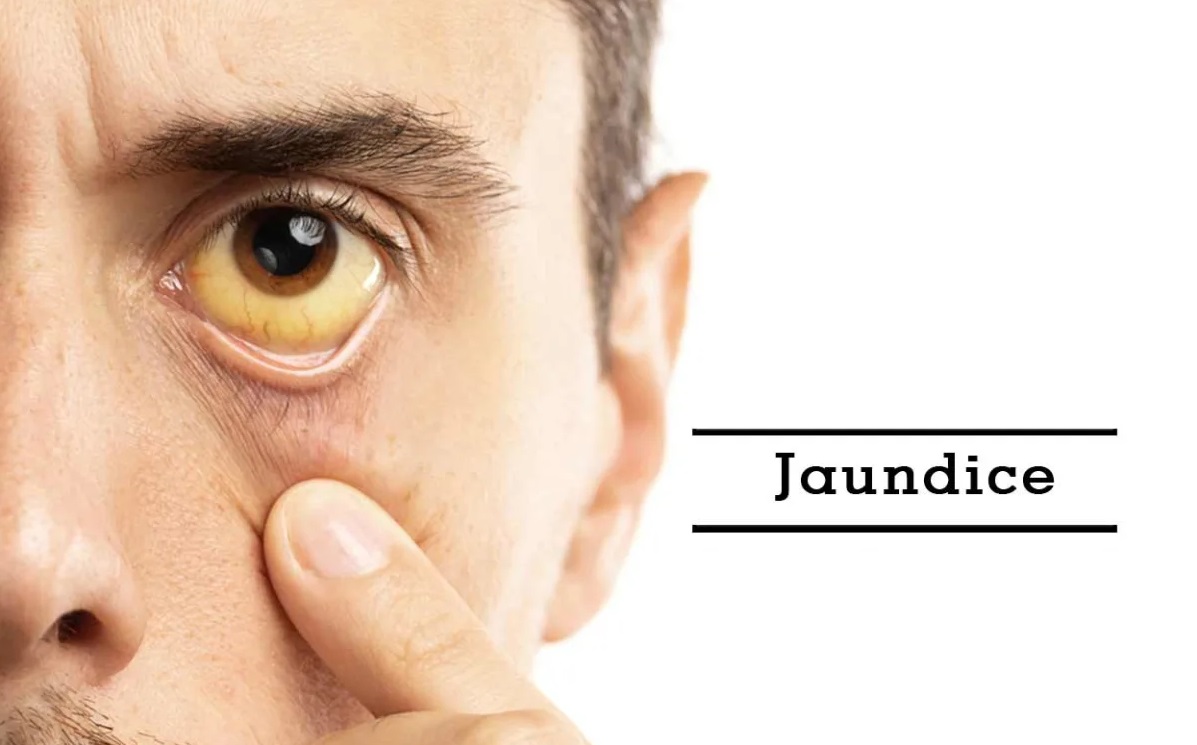


A yellowish hue can be seen on the skin, mucous membranes, and eye whites in the case of jaundice. Body fluids may also change color.
Jaundice frequently indicates a problem with the liver or bile ducts. Bilirubin, a waste product, can accumulate in the blood when the liver is not functioning properly.
A person's skin, eyes, and mucous membranes might turn yellow with moderate bilirubin levels. The hue may also transition from yellow to green as it advances. Biliverdin, a green pigment found in bile, is the cause of the color's occurrence.
People of all ages can get jaundice, which typically results from an underlying disease. The probability of having jaundice is greater in newborns and elderly persons.
The term "jaundice," also known as "hyperbilirubinemia," refers to a yellow colouring of body tissue brought on by the accumulation of excess bilirubin. Bilirubin only deposits when there is an excess, which implies either excessive production or inadequate excretion. Less than 1 mg/dL of bilirubin is considered to be the normal level in serum. However, when blood bilirubin levels exceed 3 mg/dl, it is easiest to understand the clinical presentation of jaundice with peripheral yellowing of the eye sclera, commonly known as scleral icterus. The skin will gradually turn from lemon yellow to apple green as serum bilirubin levels rise, especially if the process is ongoing. The green colour is caused by biliverdin. The evaluation and differential diagnosis of jaundice are reviewed in this activity, which also emphasises the importance of an interprofessional team in assessing and improving treatment for patients with this condition.
There are 3 main types of Jaundice
Any of the three phase of bilirubin production can have a problem, leading to jaundice.
You could have unconjugated jaundice, which is when your bilirubin levels are elevated before bilirubin is produced, as a result of:
Jaundice may develop during bilirubin production from:
Jaundice may result from obstruction (blockage) of the bile ducts after bilirubin is created from:
The following infants are most susceptible to getting newborn jaundice:
If a baby's blood type and their mother's blood type are incompatible, an accumulation of antibodies may form, which may kill the baby's red blood cells and produce a sharp increase in bilirubin levels.
Other causes of newborn jaundice include:
an abnormality in your baby’s red blood cells
On occasion, the patient may not detect their jaundice till it is accidentally found. The severity of the symptoms depends on the underlying causes and how rapidly or slowly the condition develops.
You may experience the following signs and symptoms if you have short-term jaundice, which is often brought on by an infection:
If an infection is not the source of your jaundice, you may experience symptoms including weight loss or itchy skin (pruritus). Abdominal pain is the most typical symptom if pancreatic or biliary tract malignancies are the cause of the jaundice. Jaundice associated with liver illness can occasionally occur if you have:
A baby's skin and eyes turning yellow is the first sign of jaundice. Within two to four days of delivery, the yellowing may start in the face before moving down the body.
After birth, bilirubin levels normally reach their peak 3 to 7 days later.
If a baby's skin turns yellow when a finger is lightly stroked on it, jaundice is probably present.
Yellowing may be more obvious elsewhere, such as:
On the head and face, the skin's yellowing is typically more apparent.
If you use your finger to press a section of skin down, the yellowing can also get worse.
A newborn baby with jaundice may also:
Jaundice typically starts to fade by the time the baby is 2 weeks old, about 2 days after it first appears.
Jaundice can take 5 to 7 days to manifest in premature babies, who are more susceptible to it, and typically lasts for 3 weeks.
Additionally, it typically lasts longer in infants who exclusively consume breast milk, affecting some infants for a few months.
When diagnosing jaundice, medical professionals look for signs of liver disease like:
A positive bilirubin result from a urine test, or urine analysis, indicates conjugated jaundice. The results of the urinalysis should be verified by serum testing. The serum tests will include checking the levels of bilirubin and the complete blood count (CBC).
During a physical examination, your doctor will also gauge the size and tenderness of your liver. He or she may use imaging methods like liver biopsies and computed tomographic (CT) scans to further confirm the diagnosis (ultrasonography and CT scanning, respectively).
Lab Test for Jaundice
Within 72 hours of delivery, the majority of moms and infants are released from the hospital. Because bilirubin levels peak between three and seven days after delivery, it is crucial for parents to bring their newborns in for a checkup soon after birth.
Jaundice can be detected by a baby's unique yellow coloration, but more testing may be necessary to assess how severe the condition is.
When a newborn baby exhibits jaundice within the first 24 hours of life, bilirubin levels should be checked right once using a skin test or blood test.
To determine whether a baby's jaundice is brought on by an underlying ailment, additional testing could be required. This can entail checking your baby's blood type, Rhesus factor (Rh), and complete blood count (CBC).
A Coombs test may also be carried out to look for enhanced red blood cell breakdown.
Jaundice in adults is typically left untreated. However, the fundamental problem will be addressed by your doctor.
Jaundice that is caused by acute viral hepatitis will go on its own when the liver starts to recover. Your doctor might advise surgery to open a clogged bile duct if that is the cause of the problem.
As a baby's liver starts to develop, mild jaundice will typically go away on its own. Babies will transport bilirubin through their bodies more easily with frequent feedings (eight to twelve times each day).
Other therapies can be necessary for more severe jaundice. Using light to break down bilirubin in your baby's body is a frequent and extremely efficient form of treatment known as phototherapy.
Your kid will be placed in phototherapy while dressed only in a diaper and special safety goggles, under a blue spectrum light on a special bed. You might also put a fiber-optic blanket below your infant.
The following are significant risk factors for jaundice, particularly for severe jaundice that might result in complications:
Premature birth: It's possible that a baby born before 38 weeks of pregnancy won't be able to metabolise bilirubin as quickly as a kid born at term. Additionally, premature infants may consume less and have fewer bowel movements, which results in less bilirubin being excreted in the stool.
Significant bruising during birth: The breakdown of more red blood cells during delivery may result in greater levels of bilirubin in newborns who sustain bruising.
Blood Type: The baby may have gotten antibodies through the placenta if the mother's blood type is different from that of her child, which would trigger an abnormally quick disintegration of red blood cells.
Breast-feeding: Babies who are breastfed are more likely to develop jaundice, especially if they have trouble nursing or aren't getting enough nutrients. The development of jaundice may be facilitated by dehydration or a low calorie intake. Experts still advise breastfeeding, nevertheless, because to its advantages. Making ensuring your infant eats enough and drinks enough water is crucial.
Race: According to studies, infants with East Asian ancestry are more likely to experience jaundice.
It's challenging to provide specific preventive actions for jaundice because there are numerous causes. Some general tips are:
The jaundice that affects newborns cannot be truly avoided. You are able to get your blood type checked during pregnant.
To rule out the chance of blood type incompatibility, which can cause neonatal jaundice, your baby's blood type will be tested after birth, if necessary. There are ways to stop jaundice from getting worse if your infant already has it:
Keep a close look out for jaundice-related signs in your newborn during the first five days of life, such as yellowing of the skin or eyes.
Call your doctor right away if you see signs of jaundice in your newborn.
Jaundice is a yellow discoloration of the skin and whites of the eyes caused by an excess of bilirubin, a breakdown product of hemoglobin.
Jaundice can be caused by other liver diseases, such as hepatitis or cirrhosis. It can also be caused by bile duct obstruction, which prevents bilirubin from being removed from the blood.
If you have jaundice, your skin may look yellowish or orange-tinged. In severe cases, your skin may take on a brownish color. Jaundice can also cause itching and irritation.
Foods that can be avoided Jaundice are Fatty foods such as fried foods, fatty meats, alcohol, full-fat dairy products, and oils.
If you have jaundice, your skin will likely have a yellowish hue, and your urine will become dark brown or orange. You can select a jaundice test by visiting Max lab website and book a home sample collection appointment.
Jaundice is a yellowing of the skin, whites of the eyes, and mucous membranes. It occurs when there is too much bilirubin in the blood.
To reduce jaundice, it’s important to treat the underlying condition by taking natural sunlight, eating a healthy diet, and consuming sugarcane juice will help in reducing jaundice.
In most cases, jaundice will resolve within 2 to 3 weeks without treatment. However, some forms of jaundice may require medical treatment.
 Allergy Test
Allergy Test
 Anemia Test
Anemia Test
 Auto immune
Auto immune
 Blood disorder
Blood disorder
 Bone and Joint
Bone and Joint
 Cancer Test
Cancer Test
 Cardiology Test
Cardiology Test
 Covid Recovery
Covid Recovery
 Dengue Test
Dengue Test
 Depression
Depression
 Diabetes Test
Diabetes Test
 Fatigue
Fatigue
 Fever Test
Fever Test
 Full body
Full body
 Gastro Test
Gastro Test
 Gastrointestinal
Gastrointestinal
 Gynaecology Test
Gynaecology Test
 Heart Test
Heart Test
 HIV Test
HIV Test
 Hormone Test
Hormone Test
 Hypertension
Hypertension
 Immunity Test
Immunity Test
 Infectious Disease
Infectious Disease
 Infertility Test
Infertility Test
 Influenza Test
Influenza Test
 Iron Test
Iron Test
 Kidney Test
Kidney Test
 Liver Test
Liver Test
 Lung Test
Lung Test
 Nephrology
Nephrology
 Obesity
Obesity
 Orthopedics Test
Orthopedics Test
 Physician
Physician
 Pollution Health Checkup
Pollution Health Checkup
 Pregnancy Test
Pregnancy Test
 Prostate Test
Prostate Test
 Senior Citizen Test
Senior Citizen Test
 STD Test
STD Test
 Thyroid Test
Thyroid Test
 Tuberculosis Test
Tuberculosis Test
 Vitamin Test
Vitamin Test
 Women Health Test
Women Health Test